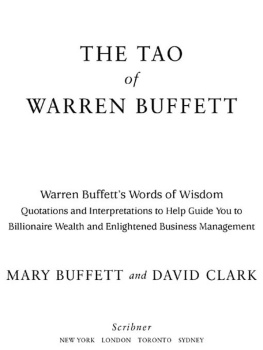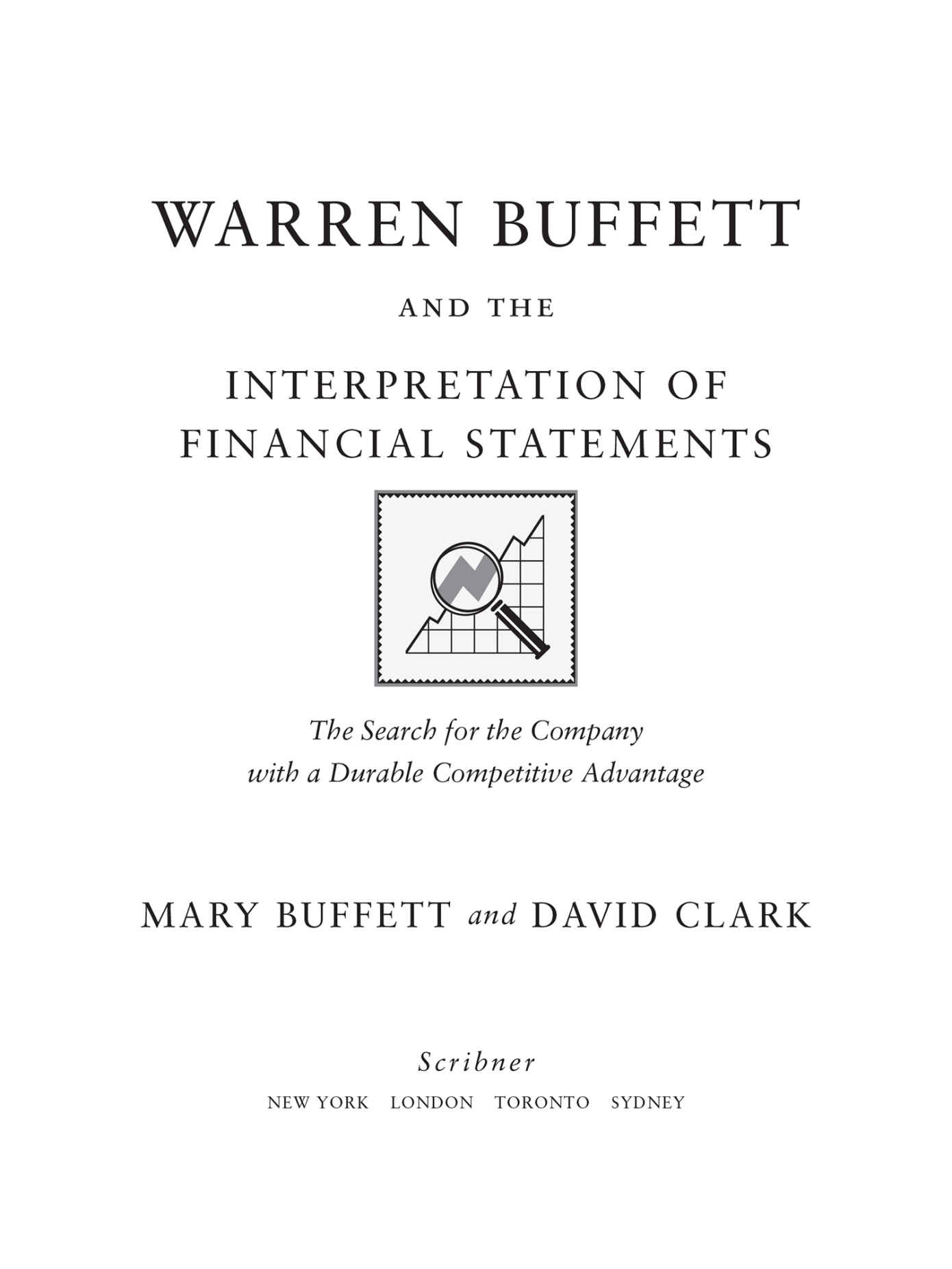Thank you for downloading this Simon & Schuster ebook.
Get a FREE ebook when you join our mailing list. Plus, get updates on new releases, deals, recommended reads, and more from Simon & Schuster. Click below to sign up and see terms and conditions.
CLICK HERE TO SIGN UP
Already a subscriber? Provide your email again so we can register this ebook and send you more of what you like to read. You will continue to receive exclusive offers in your inbox.
In loving memory of Patti Hansen Clark
Founder of the Phoenix Academy of Learning in Omaha, where over two thousand children with learning disabilities have learned to read.
To learn more about the Phoenix Academy of Learning please go to www.phoenixacademyomaha.org .
I NTRODUCTION
F or twelve years, from 1981 to 1993, I was the daughter-in-law of Warren Buffett, the worlds most successful investor and now its greatest philanthropist.
Shortly after I married Warrens son Peter, and long before most of the world outside Wall Street had ever heard of Warren, I visited their family home in Omaha. While there, I met a small group of devoted students of the master investors wisdom who referred to themselves as Buffettologists. One of the most successful Buffettologists, David Clark, kept notebooks filled with Warrens wisdom on investing, which were meticulous and endlessly fascinating to read. His notebooks were the foundation upon which he and I later shaped the internationally bestselling investment books: The Tao of Warren Buffett, Buffettology, The Buffettology Workbook, and The New Buffettology, which are now published in seventeen languages, including Hebrew, Arabic, Chinese, and Russian.
After the tremendous success of The Tao of Warren Buffett, I met up with David in Omaha during the 2007 Berkshire Hathaway annual meeting, and over lunch we fell into a discussion on the history of investment analysis. David pointed out that investment analysis during the late nineteenth century and the early part of the twentieth century was focused primarily on determining a companys solvency and earning power for the purposes of bond analysis. And that Benjamin Graham, the dean of Wall Street and Warrens mentor, had adapted early bond analysis techniques to common stocks analysis.
But Graham never made the distinction between a company that held a long-term competitive advantage over its competitors and one that didnt. He was only interested in whether or not the company had sufficient earning power to get it out of the economic trouble that had sent its stock price spiraling downward. He wasnt interested in owning a position in a company for ten or twenty years. If it didnt move after two years, he was out of it. Its not like Graham missed the boat; he just didnt get on the one that would have made him, like Warren, the richest man in the world.
Warren, on the other hand, after starting his career with Graham, discovered the tremendous wealth-creating economics of a company that possessed a long-term competitive advantage over its competitors. Warren realized that the longer you held one of these fantastic businesses, the richer it made you. While Graham would have argued that these super businesses were all overpriced, Warren realized that he didnt have to wait for the stock market to serve up a bargain price, that even if he paid a fair price, he could still get superrich off of those businesses.
In the process of discovering the advantages of owning a business with a long-term competitive advantage, Warren developed a unique set of analytical tools to help identify these special kinds of businesses. Though rooted in the old school Grahamian language, his new way of looking at things enabled him to determine whether the company could survive its current problems. Warrens way also told him whether or not the company in question possessed a long-term competitive advantage that would make him superrich over the long run.
At the end of the lunch, I asked David if he thought it would be possible to create a small, easy-to-use guide to reading a companys financial statement, using the unique set of tools Warren had developed for uncovering these wonderfully profitable businesses.
I envisioned a straightforward and easy-to-understand book that would teach investors how to read a companys financial statement, to look for the same kinds of companies that Warren does. A book that not only would explain what a balance sheet and income statement are, but would point out what investors should look for if, like Warren, they are searching for a company that possesses a long-term competitive advantage.
David loved the idea, and within a month we were trading back and forth chapters of the book you now hold in your hands, Warren Buffett and the Interpretation of Financial Statements.
We hope this book will help you make the quantum leap that Warren made by enabling you to go beyond the old-school Grahamian valuation models and discover, as Warren did, the phenomenal long-term wealth-creating power of a company that possesses a durable competitive advantage over its competitors. In the process youll free yourself from the costly manipulations of Wall Street and gain the opportunity to join the growing ranks of intelligent investors the world over who are becoming tremendously wealthy following in the footsteps of this legendary and masterful investor.
M ARY B UFFETT
J ULY 2008


You have to understand accounting and you have to understand the nuances of accounting. Its the language of business and its an imperfect language, but unless you are willing to put in the effort to learn accountinghow to read and interpret financial statementsyou really shouldnt select stocks yourself.
W ARREN B UFFETT
CHAPTER 1 T WO G REAT R EVELATIONS T HAT M ADE W ARREN THE R ICHEST P ERSON IN THE W ORLD
I n the mid-sixties Warren began to reexamine Benjamin Grahams investment strategies. In doing so he had two stunning revelations about what kinds of companies would make the best investments and the most money over the long run. As a direct result of these revelations he altered the Graham-based value investment strategy he had used up until that time and in the process created the greatest wealth-investment strategy the world has ever seen.
It is the purpose of this book to explore Warrens two revelations
- How do you identify an exceptional company with a durable competitive advantage?
- How do you value a company with a durable competitive advantage?
to explain how his unique strategy works, and how he uses financial statements to put his strategy into practice. A practice that has made him the richest man in the world.
CHAPTER 2 T HE K IND OF B USINESS T HAT W ILL M AKE W ARREN S UPERRICH
T o understand Warrens first great revelation we need to understand the nature of Wall Street and its major players. Though Wall Street provides many services to businesses, for the last 200 years it has also served as a large casino where gamblers, in the guise of speculators, place massive bets on the direction of stock prices.
In the early days some of these gamblers achieved great wealth and prominence. They became the colorful characters people loved reading about in the financial press. Big Diamond Jim Brady and Bernard Baruch are just a few who were drawn into the public eye as master investors of their era.








